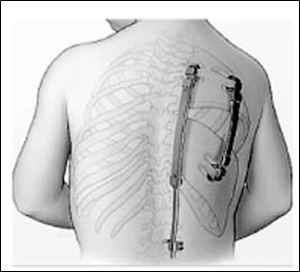
Device that saved Caleb s life credited to Texas surgeon
1/7/2007
The expandable titanium rib provides support to the spine and helps open the chest. Surgeons put the larger rib into Caleb Manuel of Toledo to correct a 120-degree curve in his spine. He may receive a smaller device in the future.
Almost 20 years ago, Dr. Robert Campbell was shown the X-rays of a youngster whose life span was measured in hours.
The child had a few ribs near his neck, a few near his waist, but none to hold his chest open. His lungs had no room to expand.
Let me make this clear, Dr. Campbell remembers his medical colleague saying, He s going to die if nothing is done.
Sign me up, Dr. Campbell responded. When s the surgery?
Tomorrow.
That was the operation that led the pediatric orthopedic surgeon from San Antonio to create the Vertical Expandible Prosthetic Titanium Rib the device that saved the life of Caleb Manuel of Toledo.
For the first surgery, Dr. Campbell, who started his education as an engineering student, took the 6 to 8-inch-long pins normally used to hold bones together. The ends were clipped off, and with sterile surgical vise grips were twisted into loops around the infant s few tiny ribs to create a column of support.
It worked. The child survived.
But Dr. Campbell knew he never wanted to do it that way again. It was tiring, and very stressful putting that much force around metal deep inside an infant, he said.
When news of the successful surgery got out, however, he started receiving requests for the procedure from all over the world. The surgeon knew he needed something better than pins and fast. The device he wanted had to be lightweight, simple, and easy to build.
That fall, vacationing on the Gulf Shore with his family, he woke up early and grabbed his kids felt-tip markers and construction paper. His doodles led to the rough concept. Two weeks later, back at work, Dr. Campbell spent nine hours creating the blueprints.
The U.S. Food and Drug Administration approved the device in 2004.
Jenni Laidman